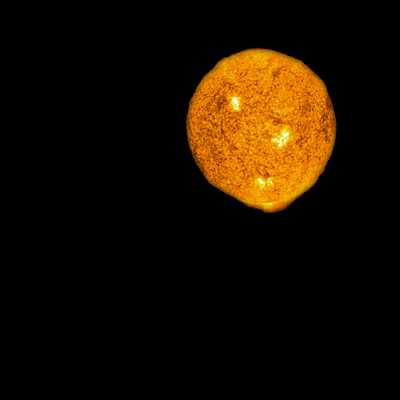
Caption: An animation illustrating Olbers' paradox (AKA dark night sky paradox) by filling the sky with stars and making the sky as bright as a star everywhere you look.
Features:
- Olbers' paradox:
If the
universe is assumed
(1) infinite,
(2) eternal,
(3) static,
and
(4) homogeneous,
then in every direction you look in
space
you should see a star
(more exactly a piece of
stellar photosphere)
and the sky should be
as bright as a
stellar photosphere---as
the animation illustrates.
Since we do NOT observe this super bright sky, one or more of the 4 assumptions is wrong.
- The assumption that is certainly wrong is the static assumption since we
observe the
expansion of the universe
meaning actually an expansion of the
observable universe.
- Actually, in the current cosmological
paradigm
Big Bang cosmology
(which likely to be true as far as it goes),
the observable universe
began in a hot dense phase (i.e.,
Big Bang era) at
lookback time the
age of the observable universe = 13.797(23) Gyr (Planck 2018)
(see Planck 2018: Age of the observable universe = 13.797(23) Gyr)
and has been expanding since then.
The observable universe
is a sphere centered on us,
the observers of the
observable universe.
Big Bang cosmology gives two causes for the blackness of space:
- Photons
from beyond the
particle horizon (i.e., the
comoving radius of the observable universe = 14.25 Gpc = 46.48 Gly current value)
have NOT had time to reach us since the
Big Bang era.
This is the main cause.
- The second cause is the
expansion of the universe
reducing the density of photons
and, via the
cosmological redshift,
causing photons
to lose energy
(i.e., photon energy E = hf = hc/λ
= 1.2398419739(75) eV-μ/λ_μ) as they propagate
across
intergalactic space.
- Photons
from beyond the
particle horizon (i.e., the
comoving radius of the observable universe = 14.25 Gpc = 46.48 Gly current value)
have NOT had time to reach us since the
Big Bang era.
This is the main cause.
- Another perspective on
Olbers' paradox
is that the
observable universe
is NOT in
thermodynamic equilibrium
because of its finite age
and the expansion of the universe.
Counterfactually if it were in thermodynamic equilibrium, all astro-bodies would be at one temperature and the radiation field in space would be a blackbody radiation field at that one temperature.
- In fact, the stars
are trying to heat up the
radiation field in
space by emitting
photons, but
they are opposed by the
expansion of the universe
as described above.
The heating up is a manifestation of the 2nd law of thermodynamics: photons are spontaneously (via random processes) flowing from the photon-dense environment inside stars to the photon-undense environment in space.
If the Λ-CDM model is correct to infinite cosmic time (which is a wild extrapolation), the stars will NEVER succeed in heating up the radiation field in space and, in fact, thermodynamic equilibrium will be achieved at absolute zero asymptotically as cosmic time goes to infinity. This grand finale is the heat death of the universe.
- The
history of Olbers' paradox
is rather intricate and goes back before
Heinrich Wilhelm Matthias Olbers'
(1758--1840) statements of
Olbers' paradox in
1823 and
1826
(see
Wikipedia:
Heinrich Wilhelm Matthias Olbers: Life and career).
In fact, the first modern statement of
Olbers' paradox
was published by
Edmond Halley (1656--1742)
in 1720 and reported
in 1721 at a meeting of the
Royal Society
with none other than
Isaac Newton (1643--1727)
presiding as
President of the Royal Society
(1703--1727).
Actually, Halley said
that he heard of the
Olbers' paradox from
someone unnamed who may have been
David Gregory (1659--1708)
(see No-377,440).
Lord Kelvin (1824--1907)
in 1901 suggested
a finite age for the
universe as a possible
resolution of Olbers' paradox
since light
from distant stars did NOT
have time to reach us.
This resolution is part of the modern one as discussed above.
Remarkably, none other than
Edgar Allan Poe (1809--1849)
suggested the same resolution in
1848
(see Wikipedia: Olbers' paradox:
History).
Image link: Wikimedia Commons: File:Olber's Paradox - All Points.gif.
Local file: local link: olbers_paradox.html.
File: Cosmology file: olbers_paradox.html.